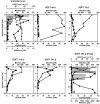Hydrocarbon Degradation in Caspian Sea Sediment Cores Subjected to Simulated Petroleum Seepage in a Newly Designed Sediment-Oil-Flow-Through System
- PMID: 28503172
- PMCID: PMC5409261
- DOI: 10.3389/fmicb.2017.00763
Hydrocarbon Degradation in Caspian Sea Sediment Cores Subjected to Simulated Petroleum Seepage in a Newly Designed Sediment-Oil-Flow-Through System
Abstract
The microbial community response to petroleum seepage was investigated in a whole round sediment core (16 cm length) collected nearby natural hydrocarbon seepage structures in the Caspian Sea, using a newly developed Sediment-Oil-Flow-Through (SOFT) system. Distinct redox zones established and migrated vertically in the core during the 190 days-long simulated petroleum seepage. Methanogenic petroleum degradation was indicated by an increase in methane concentration from 8 μM in an untreated core compared to 2300 μM in the lower sulfate-free zone of the SOFT core at the end of the experiment, accompanied by a respective decrease in the δ13C signal of methane from -33.7 to -49.5‰. The involvement of methanogens in petroleum degradation was further confirmed by methane production in enrichment cultures from SOFT sediment after the addition of hexadecane, methylnapthalene, toluene, and ethylbenzene. Petroleum degradation coupled to sulfate reduction was indicated by the increase of integrated sulfate reduction rates from 2.8 SO42-m-2 day-1 in untreated cores to 5.7 mmol SO42-m-2 day-1 in the SOFT core at the end of the experiment, accompanied by a respective accumulation of sulfide from 30 to 447 μM. Volatile hydrocarbons (C2-C6 n-alkanes) passed through the methanogenic zone mostly unchanged and were depleted within the sulfate-reducing zone. The amount of heavier n-alkanes (C10-C38) decreased step-wise toward the top of the sediment core and a preferential degradation of shorter (<C14) and longer chain n-alkanes (>C30) was seen during the seepage. This study illustrates, to the best of our knowledge, for the first time the development of methanogenic petroleum degradation and the succession of benthic microbial processes during petroleum passage in a whole round sediment core.
Keywords: crude oil; methane; methanogenesis; n-alkanes; oxygen consumption; porosity; sulfate reduction; sulfide.
Figures










Similar articles
-
Microbial Community Response to Simulated Petroleum Seepage in Caspian Sea Sediments.Front Microbiol. 2017 Apr 28;8:764. doi: 10.3389/fmicb.2017.00764. eCollection 2017. Front Microbiol. 2017. PMID: 28503173 Free PMC article.
-
Biodegradation of petroleum hydrocarbons and changes in microbial community structure in sediment under nitrate-, ferric-, sulfate-reducing and methanogenic conditions.J Environ Manage. 2019 Nov 1;249:109425. doi: 10.1016/j.jenvman.2019.109425. Epub 2019 Aug 22. J Environ Manage. 2019. PMID: 31446121
-
Volatile hydrocarbons inhibit methanogenic crude oil degradation.Front Microbiol. 2014 Apr 3;5:131. doi: 10.3389/fmicb.2014.00131. eCollection 2014. Front Microbiol. 2014. PMID: 24765087 Free PMC article.
-
A review on microbial diversity and genetic markers involved in methanogenic degradation of hydrocarbons: futuristic prospects of biofuel recovery from contaminated regions.Environ Sci Pollut Res Int. 2021 Aug;28(30):40288-40307. doi: 10.1007/s11356-021-13666-3. Epub 2021 Apr 12. Environ Sci Pollut Res Int. 2021. PMID: 33844144 Review.
-
Gas ebullition from petroleum hydrocarbons in aquatic sediments: A review.J Environ Manage. 2020 Oct 1;271:110997. doi: 10.1016/j.jenvman.2020.110997. Epub 2020 Jul 2. J Environ Manage. 2020. PMID: 32778285 Review.
Cited by
-
Long-chain n-alkane biodegradation coupling to methane production in an enriched culture from production water of a high-temperature oil reservoir.AMB Express. 2020 Apr 7;10(1):63. doi: 10.1186/s13568-020-00998-5. AMB Express. 2020. PMID: 32266503 Free PMC article.
-
Biodegradation of hydrocarbons by microbial strains in the presence of Ni and Pb.3 Biotech. 2020 Jan;10(1):18. doi: 10.1007/s13205-019-2011-2. Epub 2019 Dec 11. 3 Biotech. 2020. PMID: 31879582 Free PMC article.
References
-
- Abilov F., Orudjev A., Lange R. (1999). Optimization of oil-containing wastewater treatment processes. Desalination 124 225–229. 10.1016/j.scitotenv.2016.11.062 - DOI
-
- Akper A. (2012). Mud volcanoes in the South Caspian basin: nature and estimated depth of its products. Nat. Sci. 4 445–453.
-
- Allen A., Schlueter R., Mikolaj P. (1970). Natural oil seepage at coal oil point. Santa Barbara, California. Science 170 974–977. - PubMed
-
- Atlas R. M. (1991). Microbial hydrocarbon degradation-bioremediation of oil spills. J. Chem. Technol. Biotechnol. 52 149–156. 10.1002/jctb.280520202 - DOI
LinkOut - more resources
Full Text Sources
Other Literature Sources
Miscellaneous

